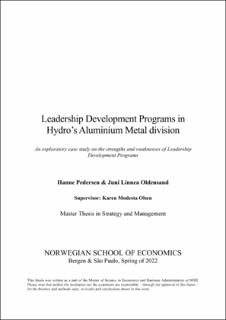| dc.description.abstract | The following thesis is a qualitative single case study based on 10 semi-structured interviews
of leaders on three different hierarchical levels in a business section of Norsk Hydro ASA
called Aluminium Metal. The purpose of this thesis is to explore how leaders in Norsk Hydro
Aluminium Metal experience the strengths and weaknesses of leadership development
programs. An extension of this becomes how leadership development programs can be used to
strengthen leadership capacity in a matrix organisation through developing its leaders and
leadership.
We have collated and studied a myriad of research and theories that currently exist in leadership
development but, in general, there is a lack of consensus about how companies can develop
their leaders and in turn, strengthen their overall leadership capacity. We have chosen to focus
on leadership development programs to limit the scope and to provide more explicit
recommendations for how to develop leaders, as this area lacks agreement in the literature.
From our qualitative interviews, we identified what the leaders consider strengths and
weaknesses of existing leadership development programs at Norsk Hydro Aluminium Metal.
Multinational companies can look to our findings when developing leadership development
programs to better equip their leaders to deal with an increasingly complex business
environment to lead their employees towards company goals and align with company values.
This can result in bolstering companies’ overall leadership capacity.
Our research found that there are two categories of leadership development programs:
developing the individual leader and developing intrapersonal relationships in the programs.
Only with both categories can leadership capacity be strengthened. Content in the programs
like mixed learning methods and getting feedback from peers and external actors were seen as
particularly important strengths for developing as a leader. The role that leadership
development programs play in facilitating networking was considered a key strength by the
leaders to develop intrapersonal relationships. On the other hand, purely presenting information
that can be found through other mediums, lack of support and unstructured follow-up and
feedback mechanisms were seen as weaknesses. Nonetheless, the importance of contextual
factors like the organisational structure of the company, bearing in mind cultural differences
and being able to transfer learnings back to the organisation need to be considered and impact
how leaders experience leadership development programs. | en_US |
